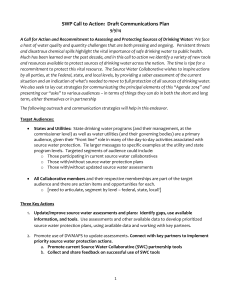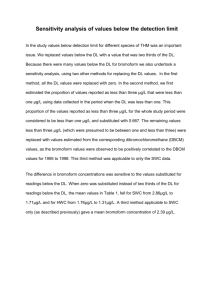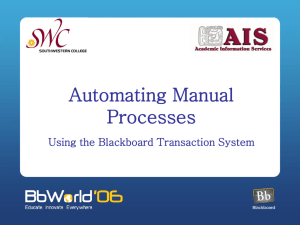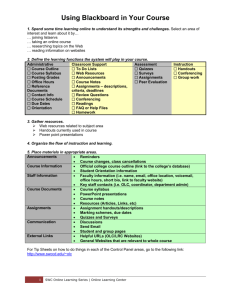Status of Women Canada March 31, 2010 Departmental Performance Report
advertisement
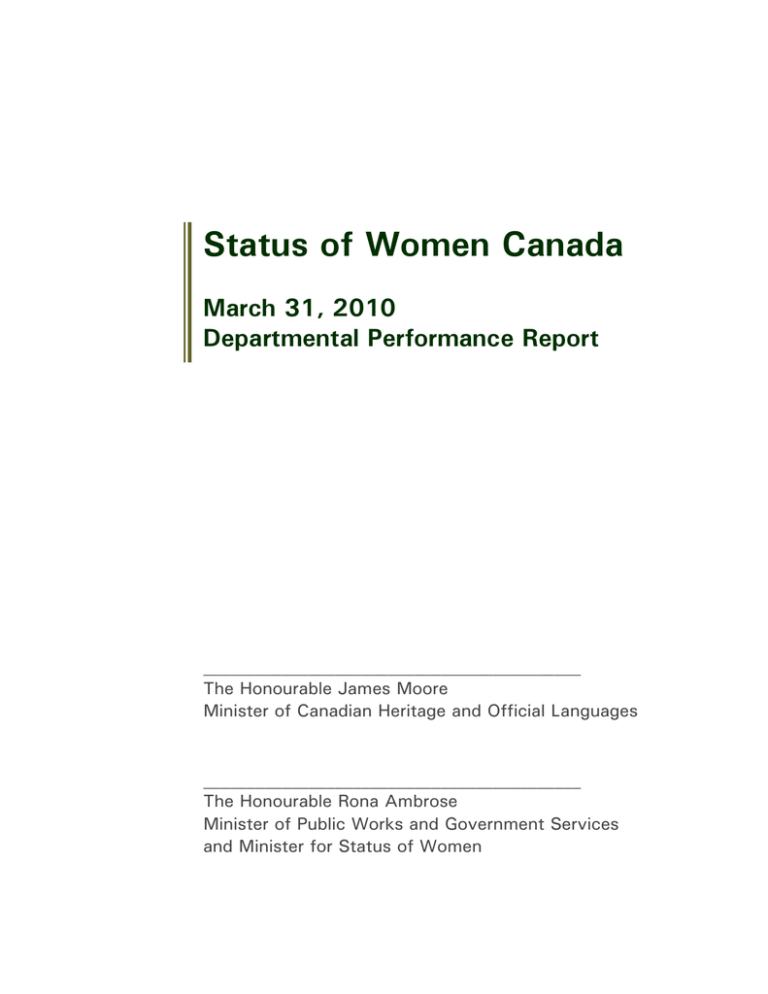
Status of Women Canada March 31, 2010 Departmental Performance Report ___________________________________________ The Honourable James Moore Minister of Canadian Heritage and Official Languages ___________________________________________ The Honourable Rona Ambrose Minister of Public Works and Government Services and Minister for Status of Women Contents Minister’s Message................................................................................1 Section I – Overview..............................................................................3 1.1 Raison d’Être and Responsibilities............................................................. 3 1.2 Strategic Outcome and Program Activity Architecture.............................. 4 1.3 Summary of Performance ......................................................................... 5 1.4 Contribution of Priorities to Strategic Outcome ........................................ 6 1.5 Risk Analysis ............................................................................................ 8 Context .................................................................................................... 8 Operating Environment............................................................................ 10 1.6 Expenditure Profile.................................................................................. 10 1.7 Voted and Statutory Items...................................................................... 11 Section II – Analysis of Program Activities .......................................13 2.1 Strategic Outcome.................................................................................. 13 2.2 Program Activity by Strategic Outcome .................................................. 14 Program Activity 1.1: Strategic Policy Analysis, Planning and Development .................... 14 Program Activity 1.2: Women’s Participation in Canadian Society .......... 16 Program Activity 1.3: Internal Services................................................... 21 2.3 Benefits for Canadians ........................................................................... 21 2.4 Lessons Learned ..................................................................................... 22 Section III – Supplementary Information ...........................................23 Contents 3.1 Financial Highlights................................................................................. 23 3.2 Financial Statements .............................................................................. 25 3.3 List of Supplementary Information Tables............................................... 25 iii March 31, 2010 Departmental Performance Report Minister’s Message As Minister for Status of Women, I am pleased to present the 2009– 2010 Departmental Performance Report for Status of Women Canada (SWC). In 2009–2010, SWC collaborated with a wide range of partners to address Government of Canada priorities. To achieve meaningful results for women in Canada, the agency focussed on three priority areas: women’s economic security and prosperity, violence against women and girls, and women’s leadership and decision-making roles, and gave particular emphasis to issues faced by Aboriginal women. I am also encouraged by the continuous progress here in Canada to support women in Afghanistan. I am pleased to report that the status of women in Canada continues to progress. Women increasingly contribute to Canada’s economic prosperity through their impressive gains in higher education, labour force participation, employment rate, income and entrepreneurship. While I am proud of these gains, there is more work to be done to ensure all women and girls across Canada live free from violence and abuse. We are committed to working with partners and stakeholders to raise awareness and support projects that will make a difference in this area. Sustained efforts by SWC, in tandem with such partners as Treasury Board Secretariat (TBS) and the Privy Council Office (PCO), have been made to strengthen gender-based analysis (GBA), integrating it more systematically into the processes of developing and implementing public policy, programs, and service delivery. Enhancing GBA continued to position Canada as a world leader in this key strategy. SWC’s investments at the local, regional and national levels addressed the economic and social situation of women and their participation in democratic life through projects that directly supported women in their communities. I am confident that the results achieved this past year have improved the lives of many women in Canada. SWC will continue to build on these achievements and strengthen our shared commitment to building a society where women enjoy a life free from violence, benefit Minister’s Message 1 March 31, 2010 Departmental Performance Report from and contribute to the economic prosperity of our country and play leadership roles in nation-building. Rona Ambrose, P.C., M.P. Minister of Public Works and Government Services and Minister for Status of Women 2 Status of Women Canada March 31, 2010 Departmental Performance Report Section I – Overview 1.1 Raison d’Être and Responsibilities The Office of the Coordinator, Status of Women, was established in 1976 with the mandate to coordinate policy with respect to the status of women and to administer related programs (Order in Council 1976-779). As a small federal agency, Status of Women Canada (SWC) carries out its responsibilities strategically, ensuring that its policy and program functions are aligned with Government priorities. SWC collaborates with a wide range of stakeholders, building synergies with other federal organizations and taking advantage of non-governmental organizations, provincial/territorial and international exchanges and best practices. In 2009–2010, SWC focussed on three priority areas: women’s economic security and prosperity, ending violence against women and girls, and promoting women’s leadership and decision-making roles. Aboriginal women’s issues were addressed through a range of policy and program activities that supported violence prevention; enhanced economic opportunities; and improved treatment of Aboriginal women when in contact with the justice system. Because women’s issues permeate society, SWC functions within a complex environment by means of policy, gender-based analysis (GBA) and program investments. SWC fostered the integration of gender equality in the development and implementation of policy, programs, and legislation both at home and abroad, providing advice across government and to stakeholders. To achieve this, SWC fostered synergies, for example, by coordinating federal input to crucial international fora. In 2009–2010, SWC, with TBS and PCO, began to oversee the phased-in implementation of the Ministerial Action Plan for Gender-Based Analysis (GBA Action Plan) to enhance federal accountability for gender equality. The yearover-year success of the GBA Action Plan can build on continued collaboration with central agencies and federal organizations. By continuing to share its expertise, SWC helped other federal organizations integrate GBA more systematically into their work and decision-making processes, with the aim of reducing inequalities between women and men in Canada. The two components of the SWC Women’s Program provided financial and professional assistance to Canadian organizations to carry out projects at local, regional and national levels that addressed the economic and social situation of women and their participation in democratic life. Section I – Overview 3 March 31, 2010 Departmental Performance Report 1.2 Strategic Outcome and Program Activity Architecture Strategic Outcome: Equality for women and their full participation in the economic, social and democratic life of Canada The chart below illustrates SWC’s Program Activity Architecture (PAA). The PAA is a major component of the Management, Resources and Results Structure (MRRS) and is used to provide financial and non-financial information with regard to performance. It depicts the alignment between resources and the two SWC program activities (PAs), and demonstrates how each PA links to expected results and contributes to the agency’s strategic outcome. Program Activity Architecture (2009–2010) The first PA is Strategic policy analysis, planning and development. The expected results of this PA are: increased policy effectiveness in addressing women’s issues and gender equality; sustainable capacity of federal departments to apply GBA; and increased integration of women’s issues in the formulation of policies and programs. This PA is aligned with the Government of Canada outcome: Government Affairs (a transparent, accountable and responsive federal government). 4 Status of Women Canada March 31, 2010 Departmental Performance Report The second PA is Women’s participation in Canadian society and its expected result is “increased participation of women in their communities.” To achieve this result, SWC provides financial and professional assistance to Canadian organizations to carry out projects designed to provide information, knowledge and tools, to develop skills and to facilitate access to opportunities and networks. In the shorter term, the results of this PA are measured by the empowerment of women to identify and remove barriers to their full participation in their communities. This PA is aligned with the Government of Canada outcome: Economic Affairs (income security and employment for Canadians). 1.3 Summary of Performance 2009–2010 Financial Resources ($ millions) Planned spending Total authorities Actual spending 31.4 32.2 31.6 2009–2010 Human Resources (FTEs) Planned Actual Difference 94 90 4 Strategic Outcome: Equality for women and their full participation in the economic, social and democratic life of Canada Performance indicators Representation of women in senior decision-making positions in the public and private sectors Targets 1% increase per year 2009–10 Performance There is steady progress toward SWC’s strategic outcome, with increased representation of women in the labour market, decision-making positions and entrepreneurship. For example: ● Close to 73% of women who worked were in fulltime employment, up from 71% in 1998. ● As of February 2009, women accounted for 41% of the senior and executive ranks in the federal public service, compared to 26% in 1999. ● Of all small and medium-sized enterprises, 47% have one or more female owners. ● In 2009, women made up 47 percent of the labour force, with 73 percent of working women in fulltime jobs, up from 71 percent in 1998. Representation of women in the labour market, including access to support programs and services for entrepreneurship 1% increase per year Participation of women in political processes/systems at the local, provincial and federal levels 1% increase per year While the progress toward or achievement of these results cannot be entirely achieved by SWC acting alone, Section II of this report demonstrates how the agency contributes to these outcomes. ... continued Section I – Overview 5 March 31, 2010 Departmental Performance Report ($ millions) Program activity Strategic policy analysis, planning and development Women’s participation in Canadian society Internal services Total 2008 –09 Actual spend ing 2009–10 Main esti mates Plan ned spend ing Total author ities Actual spend ing Alignment to Government of Canada outcomes 3.1 1.7 1.7 1.9 1.6 Transparent, accountable and responsive federal government 29.3 24.9 25.9 25.9 23.4 Income security and employment for Canadians — 3.0 3.8 4.4 32.4 29.6 31.4 32.2 6.61 31.6 In comparison with planned spending, the increase in total authorities is explained by the inclusion of the 2008–2009 eligible operating budget carryforward, collective agreements and pay list requirements. Planned spending within each program activity included forecasted expenditures which were funded centrally through internal services. This mostly explains the variance between planned spending and actual spending within each program activity. 1.4 Contribution of Priorities to Strategic Outcome In implementing its operational and management priorities, SWC was guided by its three areas of focus: women’s economic security and prosperity, violence against women and girls, and women in leadership and decision-making roles. While balancing multi-year commitments, SWC ensured that Aboriginal women’s issues were integrated, as a cross-cutting theme, in all its policy and program activities. Given the audit of GBA practice in government, undertaken by the Office of the Auditor General, SWC has put a particular focus on working toward the strengthening of the overall federal approach to GBA. In close collaboration with central agencies and key federal organizations, SWC engaged in interdepartmental consultations, forging synergies on specific issues and strengthening the advisory role in policy. 1 6 The variance between planned spending and actual spending under Internal Services is a result of having centralized the accounting for certain expenditures, such as the cost for the employee benefit plan. Previously, these costs were accounted for across the three program activities. Status of Women Canada March 31, 2010 Departmental Performance Report In 2009–2010, work on the Values and Ethics Framework continued with the objective of developing a Code of Conduct for the agency. Building on the previous-year activities, emphasis was placed on consultations with staff in order to finalize SWC’s Code of Conduct. Meetings were held with a sampling of staff from directorates to determine how the TBS Model Organizational Code of Conduct for Public Sector organizations could inform SWC’s process. Training sessions were also offered to staff on workplace conflict resolution as part of on-going promotion and prevention activities on values and ethics. The Advisory Committee on Values and Ethics is currently engaged in crafting the agency’s Code of Conduct. Operational Priorities Priority Type Status Develop an action plan to advance equality for women New Mostly met Invest in projects that address the three priority areas: women’s economic security and prosperity, violence against women and girls, and women in leadership and decision-making roles Previously committed 2 As SWC continues to work toward a federal Action Plan to Advance Equality for Women, three key areas2 were used to guide the implementation of its operational priorities. Met all SWC-funded projects demonstrated progress toward the expected results by providing women with access to opportunities, improving the quality and/or availability of services for women who experience violence and by informing and supporting women to assume leadership roles. Linkages to strategic outcome Equality for women and their full participation in the economic, social and democratic life of Canada. The three areas of priority are: women’s economic security and prosperity, violence against women and girls, and women’s leadership and decision-making roles. Section I – Overview 7 March 31, 2010 Departmental Performance Report Management Priorities Priority Type Status Develop and implement a Corporate Risk Profile New Mostly met Continue work on the Values and Ethics Framework Enhance areas for improvement identified in the Management Accountability Framework (MAF) assessment Linkages to strategic outcome While SWC continues to manage risks using existing tools, efforts are underway to implement integrated risk management by updating the agency’s CRP, developing risk management capacity and enhancing accountability for risks. Previously Mostly met committed Building on the previous-year activities, SWC consulted with staff, provided training and engaged its Advisory Committee to complete work on the agency’s Code of Conduct. New Equality for women and their full participation in the economic, social and democratic life of Canada. Mostly met SWC continued to enhance its management capacity by taking specific measures to address areas of management identified for improvement through the MAF assessment. 1.5 Risk Analysis Context The need for SWC to persist in fostering equal participation by women in the Canadian economy, society, and leadership continued. SWC fulfills its mandate in an external context which was characterized by steady progress on advancing the status of women, despite equality gaps between women and men in certain areas. Women in growing numbers continued to enter the labour force; occupy well-paying jobs; move up the corporate ladder; and become entrepreneurs. For example: ● In 2008, the employment rate for women increased to almost 64 percent, up from 60 percent in 1998; ● In 2009, women made up 47 percent of the labour force, with 73 percent of working women in full-time jobs, up from 71 percent in 1998; 8 Status of Women Canada March 31, 2010 Departmental Performance Report ● In business and finance, women occupied 51.1 percent of professional occupations3; ● At 55 percent, women outnumbered men in federal public service positions, holding 56 percent of knowledge-based jobs and 40 percent of executive positions, including 12 of the 29 deputy minister positions; ● In Canada, four out of five businesses were started by women. As a result, women today are in a better position to contribute to their family earnings and to their country’s economic growth and prosperity. Advances were tempered, however, by such persistent equality gaps in key areas as: Economic Prosperity and Security ● The wage gap remained. In 2008, women earned 84 cents for each dollar earned by men, with more vulnerable women experiencing the greatest economic insecurity. ● Women’s part-time employment rates were higher than those of men in every age group. In 2009, 25% of women aged 15 years and over worked part-time compared to 11% of men. Violence Against Women and Girls Canadian data shows that violence against women remained high. ● In 2007, nearly four times as many women as men were killed by a current or former spouse. Of all police-reported violent crimes, 12 percent were incidents of spousal violence, with women accounting for 83 percent of these victims. ● The rate of domestic sexual assault was four times higher for girls than for boys. ● Violence against Aboriginal women occurred at three times the rate of other women in Canada. Leadership and Decision-Making Roles ● In January 2010, in democratic leadership in Canada, women held 21 per cent of the seats in the House of Commons, 34 per cent of Senate seats, 27 per cent of Cabinet posts. ● In private sector leadership in 2009, no women were found on the boards of 40 percent of the Financial Post 500, where, overall, women held only 14 percent of the board seats. Board seats are a pivotal determinant of career advancement for all women. 3 http://www.catalyst.org/publication/247/women-in-management-in-canada. Section I – Overview 9 March 31, 2010 Departmental Performance Report Operating Environment In 2008–2009, SWC participated in the tri-annual Management Accountability Framework (MAF) assessment for the second time. While the MAF Round VI assessment recognized SWC’s strong performance, it also identified areas that required improvement. A priority noted for SWC was corporate risk management, including the need to develop a Corporate Risk Profile (CRP), enhance risk management capacity and management accountability for key risks. In its Report on Plans and Priorities for 2009–2010, SWC committed to implementing integrated risk management during the reporting year. Although the absence of a robust CRP remains a significant risk to SWC, the agency continued to mange risks effectively during the reporting year by using existing risk mitigation tools. At the same time, work continues to implement integrated risk management in the organization, including updating the current CRP. SWC will also deliver staff training, develop tools and ensure management accountability for risks so as to ensure that risk information is integrated in its decision-making process and operational activities. 1.6 Expenditure Profile In 2009–2010, SWC spent a total of $31.6 million to carry out its PAs, to achieve expected results and to advance its planned strategic outcome. As seen in the chart below, SWC had a very slight year-over-year decrease in spending from 2005–2006 to 2006–2007. In 2007–2008, the sharp decrease in year-over-year planned spending was a result of SWC’s participation in the Expenditure Restraint exercise. The sharp increase in year-over-year authorities was a result of additional funding made available to SWC through Budget 2007. SWC was unable to fully expend the Budget 2007 funding since it was received late in 2007–2008. The increase in spending in 2008–2009 and beyond reflects the fact that SWC received this new funding earlier in the Estimates process. 10 Status of Women Canada March 31, 2010 Departmental Performance Report 1.7 Voted and Statutory Items ($ millions) Vote # or statutory item (S) Truncated vote or statutory wording 2007– 08 Actual spend ing 2008– 09 Actual spend ing 2009– 10 Main esti mates 2009– 10 Actual spend ing 85 Operating expenditures 8.4 9.4 8.6 9.8 90 Grants and contributions 15.2 22.0 19.9 20.5 101 Pursuant to Section 24.1(1) of the Financial Administrative Act, to forgive a debt 0.7 — — — (S) Contributions to employee benefit plans 0.9 1.0 1.1 1.3 (S) Minister for Status of Women motor car allowance ($2000 per fiscal year, starting 2008–09) — 0.0 0.0 0.0 25.2 32.4 29.6 31.6 Total Section I – Overview 11 March 31, 2010 Departmental Performance Report 12 Status of Women Canada March 31, 2010 Departmental Performance Report Section II – Analysis of Program Activities 2.1 Strategic Outcome Equality for women and their full participation in the economic, social and democratic life of Canada SWC’s strategic outcome is measured by using performance indicators that demonstrate the extent to which women are represented in the labour market (including entrepreneurship), senior decision-making positions in public and private sectors and the democratic process at local, provincial and federal levels. Progress toward this strategic outcome was monitored using the SWC Performance Measurement Framework (PMF), which identifies the expected results, performance indicators and targets. SWC recognizes the limitations of its current PMF and is committed to improving the tool to ensure its effectiveness in the collection and analysis of its outcome data and in reporting its performance. At the same time, SWC is exploring various strategies to start the process of measuring progress toward its strategic outcome. In 2009–2010, SWC supported the increased representation of women in senior decision-making positions, in the labour market, and in democratic participation by addressing key systemic barriers faced by women. The performance analysis presented in this section shows how SWC’s PAs contributed to the agency’s strategic outcome. Section II – Analysis of Program Activities 13 March 31, 2010 Departmental Performance Report 2.2 Program Activity by Strategic Outcome Program Activity 1.1: Strategic Policy Analysis, Planning and Development 2009–10 Financial resources ($ millions) 14 2009–10 Human resources (FTEs) Planned spending Total authorities Actual spending Planned Actual Difference 1.7 1.9 1.6 15 14 1 Expected results Performance indicators Increased policy effectiveness in addressing women’s issues and gender equality Number of departments that respond to women’s issues effectively through policy/program formulation and implementation 3–5 departments per year Mostly met Seventeen federal departments or agencies reported that they perform and integrate GBA into relevant policy options. Sustainable capacity of federal government departments to apply GBA Percentage of other government departments with increased capacity to incorporate GBA into their policy and program activities 3–5 departments per year Mostly met Thirteen federal organizations reported that they have in place four out of the five elements required for GBA implementation. Increased integration of women’s issues in the formulation of policies and programs Number of new and improved policies and programs that respond to women’s issues 3–5 policies per year Mostly met In addition to continued GBA training and advice, SWC helped to identify barriers faced by women-owned businesses in the federal procurement process, laying the groundwork for future developments through membership in the Working Group on Small and Medium Enterprise (SME) Concerns, led by Public Works and Government Services Canada. Targets Performance status Performance summary Status of Women Canada March 31, 2010 Departmental Performance Report Performance Analysis In 2009–2010, the first PA—strategic policy analysis, planning and development—supported systemic changes in decision-making processes that shaped policy formulation, program development, resource allocation and legislative initiatives. SWC enabled improved gender-responsive decision-making systems across the federal government through better GBA practices, as well as by providing policy advice that was adopted, and resulted in meaningful changes to policy, program, and legislative development and implementation across government. This PA also engaged in organizational capacity-building, providing training, tools and expert advice. It provided policy commentary on Cabinet documents and the policy and program work of other federal organizations, while monitoring and providing Canada’s input to international bodies. Sustainable Capacity of Federal Government Departments to Apply GBA: SWC’s progress with GBA received added impetus from the 2009 Report by the Office of the Auditor General (OAG) on its audit of the implementation of GBA in seven departments and agencies. In its response to the 2009 OAG Report, the Government of Canada committed to improving the practice of GBA by clarifying expectations concerning its application and by instituting an annual assessment of its effectiveness within the federal government. SWC, in collaboration with TBS and PCO, tabled with the Public Accounts Committee the Action Plan on Gender-Based Analysis (GBA Action Plan), a guideline to implementing GBA. This plan aims to help build sustainable institutional capacity to apply GBA across the federal government. A survey of 37 departments and 25 agencies by SWC and TBS showed continued improvement in incorporating GBA into federal organizations. In addition to five of the seven departments audited, 12 other departments and agencies reported that they perform and integrate GBA into policy options, where relevant. Furthermore, 13 of the surveyed organizations reported that they have in place four out of five key elements of a sound GBA framework (i.e., departmental policy, roles and responsibilities defined, tools and methodologies readily available, a responsibility centre such as a champion). The achievements of 2009–2010 in implementing the GBA Action Plan show the effectiveness of SWC as a catalyst for building GBA capacity. SWC, in collaboration with TBS and PCO, assisted the OAG-audited departments, using informal discussions and panel presentations to improve their GBA capacity. The current progress on GBA capacity building is expected to lead to improved public policies that address the needs of Canadian women and men and their families, a fundamental objective to advancing equality for women. The GBA Action Plan can achieve cumulative progress through successive annual cycles toward this PA’s expected results. Increased Integration of Women’s Issues in the Formulation of Policies and Programs: Policy and program work on women’s economic Section II – Analysis of Program Activities 15 March 31, 2010 Departmental Performance Report prosperity and security continued during the reporting year. SWC’s recommendations to the Department of Indian and Northern Affairs resulted in the inclusion of gender-specific targets for objectives and reporting in the framing of its Aboriginal Economic Development Framework. This is an important example of how SWC facilitated the development of increased economic opportunities for women. Violence Against Women and Girls: SWC policy and programs addressed this priority area in many ways. In response to the ongoing vulnerability of Aboriginal and immigrant women to human trafficking, SWC continued its collaboration with the Royal Canadian Mounted Police to deliver training on human trafficking to officials in law enforcement, the justice system, and border and immigration services. International: SWC contributed to Canada’s role in international efforts to advance the status of women world-wide: ● SWC led Canada’s participation in the 54th Session of the UN Commission on the Status of Women. It coordinated with other federal departments to provide Canada’s input and link other countries’ experiences in advancing gender equality with Canada’s domestic objectives. ● At the Beijing + 15 meeting in March 2010, SWC played a key role in negotiating several UN resolutions to reflect Canadian priorities and integrate gender equality into national processes, structures, and accountabilities. SWC actively supported Canada’s reaffirmation of the Beijing Declaration and the Beijing Platform for Action, ensuring the latter continues to serve as the international standard. ● For the Commonwealth Women’s Affairs Ministers forum, SWC worked to ensure that concrete evidence of Canada’s progress in critical areas was included in the Mid-Term Review of the Commonwealth Gender Plan of Action. The Mid-Term Review will form the basis of an important international report on the state of gender equality in the Commonwealth for the period 2007–2009. Program Activity 1.2: Women’s Participation in Canadian Society 2009–10 Financial resources ($ millions) 2009–10 Human resources (FTEs) Planned spending Total authorities Actual spending Planned Actual Difference 25.9 25.9 23.4 32 32 — ... continued 16 Status of Women Canada March 31, 2010 Departmental Performance Report Expected results Performance indicators Targets Increased participation of women in their communities Proportion of funded projects that demonstrate level of women’s participation in their communities 10% of projects Increase awareness among women in identifying and/or removing barriers to their participation in their communities Proportion of funded projects that demonstrate raised awareness or knowledge acquisition among women in identifying and/or removing barriers to their participation in their communities 10% of projects Increased partnerships with other federal departments, levels of government, NGOs and the private sector Proportion of funded projects involving partners addressing women’s issues through joint projects Approximately 10% of projects Performance status Performance summary Met all Performance analysis shows that there is progress toward the expected results of this program activity. SWC-funded projects resulted in concrete outcomes for women and girls Met all through: ● Empowering and supporting diverse groups of women, including hard-to-reach populations, in accessing a range of opportunities, information, services, tools, etc. that are helping project participants in integrating Met all into their communities. ● Projects that highlight innovative frameworks, best practices and promising models that may be showcased in an effort not only to share knowledge, but also to explore opportunities to pilot them in different parts of the country or for different populations of women. ● Resources leveraged for investment on gender equality through diverse partnerships (federal, provincial and municipal organizations, the private sector and NGOs). Performance Analysis Strategic Investments In 2009–2010, SWC made strategic investments through its second PA— women’s participation in Canadian society. It continued to provide financial assistance to women’s and other Canadian organizations addressing significant barriers to participation faced by Canadian women. A total of 357 projects received financial and/or other support from SWC in 2009–2010. Total funding expended for these projects during the reporting year was $19,495,268. Of the 357 projects, 83 were new projects. As a result of the call for proposals launched under the Women’s Community Fund, 486 project Section II – Analysis of Program Activities 17 March 31, 2010 Departmental Performance Report proposals were received, of which 78 were approved for funding. SWC also approved five new Women’s Partnership Fund projects. The large number of proposals received and women being reached continue to indicate that the need for supporting women in an effort to improve their social and economic condition and facilitate their participation in the democratic life of Canada is significant. By determining funding priorities, SWC invested strategically in areas where the need and the potential to achieve results were the greatest, and where there was a clear potential to make a concrete and direct difference. All projects contributed to one or more of the SWC priority areas: ● improving women’s economic security and prosperity; ● ending violence against women and girls; and ● encouraging women and girls in leadership and decision-making roles. SWC-funded projects are diverse in nature and scope, target different beneficiaries, address various issues, apply a variety of strategies and implement various activities (e.g., training, workshops, resource development, outreach, peer support, mentorship, information provision, service improvement, etc.).The projects funded through the Women’s Program generally addressed concrete outcomes for women and girls, but also worked, wherever possible, to remove systemic barriers impeding women’s progress and equality. SWC also facilitated, where possible, the networking of different groups that share a common goal as well as helped groups gain access to or provided access to resource materials and tools that help organizations work more effectively. Through this PA, SWC leveraged a significant amount of “partnership” dollars supporting diversification of funding sources for projects that address women’s issues. In 2009–2010, SWC engaged and/or leveraged funding from a number of Canadian organizations in the public, private, and voluntary sectors in advancing the full participation of women in the economic, social, cultural and democratic life of Canada. An example of partnership building and program investments is SWC funding to the Alberta Council of Women’s Shelters for the “Uniting to End Violence against Women” initiative. Their work will be carried out in collaboration with stakeholders, including government departments, community-based service providers, and women who are victims of family violence. This three-year project is groundbreaking in that it will bring together provincial/territorial shelter organizations across Canada to work to improve the access to and quality of services for women who are in abusive situations. The project will coordinate the national exchange and implementation of proven, promising, and innovative practices and service delivery models across Canada, through the establishment of a national network, including a strategy and action plan to link women’s shelters across Canada. By helping to establish a strong national voice, shelters will 18 Status of Women Canada March 31, 2010 Departmental Performance Report be able to act together to identify and effectively address their common issues and goals. Progress Toward Outcomes Projects funded under the Women’s Program demonstrate progress toward the expected results: increased awareness among women in identifying and/or removing barriers to their participation in their communities; and increased partnerships with other federal departments, levels of government, NGOs and the private sector. These results are achieved through Women’s Program projects that support diverse groups of women, including hard-toreach populations, in accessing a range of opportunities, information, services, tools, etc. that can facilitate women’s participation in Canadian society in multiple sectors. Economic Security and Prosperity: In 2009–2010, completed projects which addressed women’s economic security and prosperity worked to provide diverse groups of women with access to opportunities that could, for example, facilitate labour market integration by: ● making women aware of available local supports and resources; ● facilitating access to services through outreach, service improvement; ● providing support with recruitment, retention and advancement in nontraditional occupations; ● developing community action plans in support of new childcare models in rural communities; ● supporting women entrepreneurs in growing their businesses; and ● providing skill development on the topics of: financial literacy, business management and leadership, pre-employment skills, and life-skills, etc. An area of intervention in 2009–2010 was support to women in nontraditional occupations. Projects included support with recruitment, retention and advancement in industrial construction trades and technology fields and business growth for women entrepreneurs. A project supported the development of partnerships with employers to assist women in entering the building trades and to retain women in the sector. Ending Violence Against Women and Girls: Completed projects which addressed violence against women primarily addressed awareness and access issues, specifically supports relating to domestic and dating violence and improving the quality of and/or availability of services for women experiencing violence through: ● awareness about the different forms of violence against women; ● knowledge about available community resources; ● tool development to support women who have been abused; ● support to women at different stages in addressing the issue of violence in their lives; Section II – Analysis of Program Activities 19 March 31, 2010 Departmental Performance Report ● service improvement (access, including cultural relevancy and quality); and ● increasing access to services through outreach. For example, a handbook has been completed and will help organizations facilitate workshops for sex workers addressing treatment. The handbook provides information missing in traditional support services. It uses innovative approaches to assist sex workers and sexually exploited youth’s transition to recovery, their successful exit from the sex trade, entry to mainstream employment and meaningful involvement in their communities. The handbook has brought new and innovative resources for communities and organizations to address the unique needs of women and girls in the sex trade. Women and Leadership: In 2009–2010, completed projects which addressed women and leadership informed and/or supported diverse women with barriers in accessing various leadership roles, including: community leaders, board service, elected positions, and community action through information, tools and different opportunities, by: ● providing women with knowledge and tools to achieve board appointments; ● familiarizing women with Canadian governance processes; ● developing tools to support the political participation of women (including culturally relevant tools); ● developing the leadership skills of girls and young women and potential community leaders. Projects ranged from providing qualified women with knowledge and tools to achieve board appointments to the development of a new on-line culturally relevant stand alone module aimed at increasing the political participation of Aboriginal women. For example, participants increased their skills and understanding of how to be recruited successfully for service on the boards of community agencies, including how to position themselves for board placement, and develop personal action plans in pursuit of board seats. There are signs that support to women is helping project participants in integrating into their communities. The projects highlight innovative frameworks, best practices and promising models that may be showcased in an effort not only to share knowledge, but also to explore opportunities to pilot them in different parts of the country or for different populations of women. 20 Status of Women Canada March 31, 2010 Departmental Performance Report Program Activity 1.3: Internal Services 2009–10 Financial resources ($ millions) 2009–10 Human resources (FTEs) Planned spending Total authorities Actual spending Planned Actual Difference 3.8 4.4 6.6 47 44 3 Planned spending within each program activity included forecasted expenditures which were funded centrally through Internal Services. This mostly explains the variance between planned spending and actual spending within each program activity. Internal Services are groups of related activities and resources that are administered to support the needs of programs and other corporate obligations of an organization. These groups are: Management and Oversight Services; Communications Services; Legal Services; Strategic Planning and Reporting, Audit and Evaluation, Human Resources Management Services; Financial Management Services; Information Management Services; Information Technology Services; Real Property Services; Materiel Services; Acquisition Services; and Travel and Other Administrative Services. It also includes the budget for the Office of the Minister for Status of Women. 2.3 Benefits for Canadians As indicated in its MRRS, SWC’s strategic outcome—equality for women and their full participation in the economic, social and democratic life of Canada— represents an enduring benefit to Canadians. As the performance analysis shows, SWC, through its two PAs, is a catalyst for achieving its planned strategic outcome. SWC policy work enabled a growing number of departments to apply GBA, evidence of increasing institutional capacity to develop effective and inclusive policies and programs that improve the status of women in Canada. At the same time, with the growing number of women empowered with information, awareness, knowledge, skills, tools and opportunities, SWC expects to achieve demonstrable increases in the participation of women in the economic, social and democratic life of Canada. These results will contribute to the Government of Canada outcomes: transparent, accountable and responsive federal government and income security and employment of Canadians. Section II – Analysis of Program Activities 21 March 31, 2010 Departmental Performance Report 2.4 Lessons Learned In 2009–2010, opportunities and challenges provided valuable insights that will inform the agency’s work in coming years. As a small agency, SWC faced the challenges associated with a growing demand for policy and programming advice and intervention. For SWC to fulfill its role as enabler and effective catalyst for change, a more strategic approach to policy and programming activities could be beneficial. Specifically: ● More targeted engagement with the federal family to leverage partnerships and investments; ● Building synergies through partnerships both in Canada and internationally; ● By recalibrating systems and processes to increase the responsiveness of the agency; ● Deepening analyses to further inform future strategic programming investments; ● Continue proactive renewal processes to ensure uninterrupted corporate memory while integrating fresh perspectives on policy, programs, and management, including full implementation of its risk management strategy. 22 Status of Women Canada March 31, 2010 Departmental Performance Report Section III – Supplementary Information 3.1 Financial Highlights TBS has updated the Accounting Standard 1.2 on Departmental and Agency Financial Statements which comes into effect in 2010–2011. SWC has elected to adopt the new standard early and, due to new requirements in the standard, has restated its 2008–2009 statements of financial position and equity. Condensed Statement of Financial Position at End of Fiscal Year (March 31, 2010) % Change 2008–09 Restated 2009–10 ASSETS Financial assets Non-financial assets Total Assets 27% 2,785,407 3,538,994 –41% 463,638 272,660 17% 3,249,045 3,811,654 13% 4,717,928 5,352,850 –5% (1,468,883) (1,541,196) 17% 3,249,045 3,811,654 LIABILITIES Total Liabilities EQUITY Total Equity TOTAL Condensed Statement of Operations at End of Fiscal Year (March 31, 2010) % Change 2008–09 2009–10 –3% 33,818,263 32,895,290 –100% 145 — –3% 33,818,118 32,895,290 EXPENSES Total Expenses REVENUES Total Revenues NET COST OF OPERATIONS Total assets were approximately $3.8 million at the end of 2009–2010, a 17% increase over the previous year’s total. Total assets are comprised of: 92% or approximately $3.5 million is “Due from the Consolidated Revenue Fund”; 7% or approximately $0.3 million is “Tangible Capital Assets”; and 1% or $0.02 million is “Receivables and Advances.” Section III – Supplementary Information 23 March 31, 2010 Departmental Performance Report In 2009–2010, SWC conducted a review of all its capital assets and associated amortization. Changes and corrections required led to the sharp decrease in its non-financial assets from 2008–2009. Total liabilities were $5.4 million at the end of 2009–2010, a 13% increase from the previous year’s total. Accounts payable and accrued liabilities are the largest component of liabilities. Together they represent 69% of total liabilities. The 13% increase is mostly explained by the addition of new accounts payable for transfer payments to different organizations. In 2009–2010, SWC’s total expenses were $32.9 million, a 3% decrease from the previous year’s total. This decrease is mostly explained by the slight drop in funding available for Transfer Payments as less funding was reprofiled from previous fiscal years. 24 Status of Women Canada March 31, 2010 Departmental Performance Report 3.2 Financial Statements For financial statements, please visit: http://www.swc-cfc.gc.ca/account-resp/pr/fin/0910-eng.html 3.3 List of Supplementary Information Tables The electronic Supplementary Information Tables in the 2009–2010 Departmental Performance Report can be found on the Treasury Board of Canada Secretariat’s website at: http://www.tbs-sct.gc.ca/dpr-rmr/2009–2010/index-eng.asp Section III – Supplementary Information 25 March 31, 2010 Departmental Performance Report Contact Information For questions on financial information, contact: Cynthia Paquette Director, Corporate Services Telephone: 613-947-1453 Fax: 613-947-6113 E-mail: cindy.paquette@swc-cfc.gc.ca For other questions, contact: Ainalem Tebeje Manager, Strategic Planning, Audit and Evaluation Telephone: 613-995-1811 Fax: 613-943-2386 E-mail: ainalem.tebeje@swc-cfc.gc.ca For other publications, please visit the SWC web site: http://www.swc-cfc.gc.ca 26 Status of Women Canada
